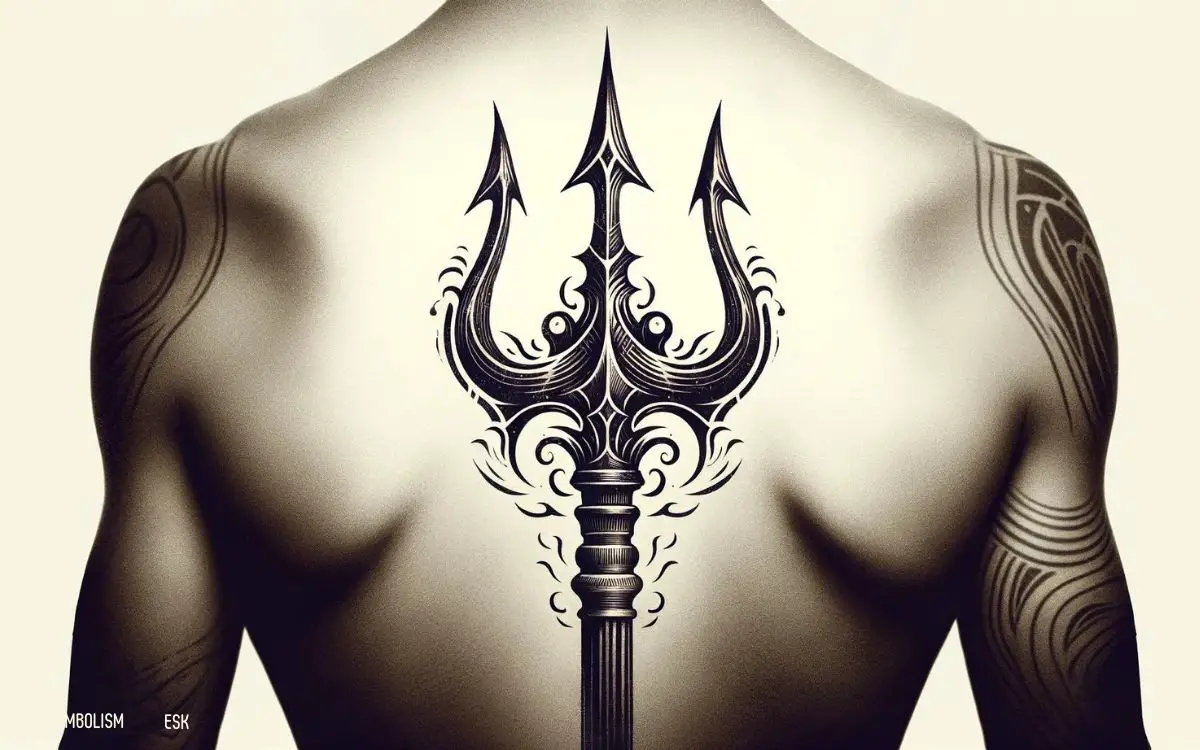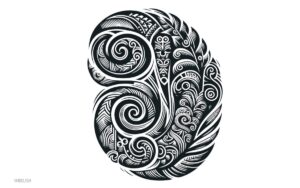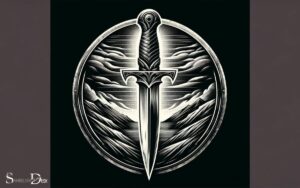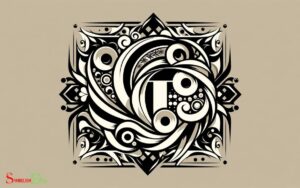What Does a Trident Tattoo Symbolize? Control!
A trident tattoo symbolizes power, control, strength, and a connection to the sea. Often associated with gods like Poseidon or Shiva, it also represents authority and divine rule.
The trident is a historical and mythological symbol with varied meanings:
Embark on a journey of self-expression with the trident tattoo, a mark of divine power and the unyielding strength of the ocean’s waves.

Key Takeaway
Historical Origins of the Trident Symbol
The trident symbol has frequently appeared throughout history in various cultures and holds significant meaning in each of its representations.
- In Greek mythology, the trident was associated with Poseidon, the god of the sea. It symbolized his power and authority over the waters.
- In Hindu culture, the trident, known as the Trishula, is associated with Lord Shiva and represents the three aspects of existence – creation, preservation, and destruction.
Additionally, the trident has been a symbol of strength and protection in various maritime traditions, where it represented control over the seas.
Its historical origins are deeply rooted in the beliefs and mythologies of these cultures, reflecting power, authority, and the forces of nature.
Understanding these origins provides insight into the diverse meanings and significance of the trident symbol.
Mythological and Religious Significance
The trident holds great mythological and religious significance, representing power and authority. It’s often associated with the Greek god Poseidon, symbolizing his dominion over the sea.
Additionally, the trident’s three-pronged design is believed to represent control over the three realms of the universe – the heavens, the earth, and the waters.
Symbol of Power
Associated with mythological and religious significance, the trident tattoo symbolizes power and authority in various cultures and belief systems.
- In Greek mythology, the trident is the weapon of Poseidon, the god of the sea, symbolizing his dominion over the waters and his formidable power.
- In Hinduism, the trident is associated with Lord Shiva, representing his control over the three aspects of the universe: creation, preservation, and destruction.
- Additionally, in some interpretations, the trident is seen as a symbol of spiritual growth and the three main energy channels in the human body.
The trident’s association with powerful deities and its depiction as a formidable weapon underscores its representation of strength, control, and authority in diverse mythological.
Connection to Poseidon
A trident tattoo symbolizes a connection to Poseidon, the god of the sea in Greek mythology, signifying power and authority.
In Greek mythology, Poseidon was revered as the ruler of the seas, and his trident was a symbol of his dominion over the waters.
Those who choose to ink a trident on their skin often do so to express their admiration for the strength and control associated with Poseidon.
The trident also holds religious significance, as it represents the divine authority of Poseidon and his ability to create storms, earthquakes, and tsunamis.
For many, this tattoo serves as a reminder of the mythical and religious power that Poseidon holds, and it reflects their personal connection to the sea and its mysteries.
Representing Three Realms
Representing the trinity of land, sea, and sky, the trident holds mythological and religious significance, reflecting the power and influence of Poseidon over these realms.
- In various mythologies, the trident is associated with the three realms of the earth, the sea, and the sky. It symbolizes the control and authority of Poseidon, the Greek god of the sea, over these domains.
- In Hindu mythology, the trident, known as the trishula, represents the three aspects of God: creation, maintenance, and destruction. It’s wielded by Lord Shiva, signifying his supremacy over the three realms.
- Similarly, in Christianity, the trident is sometimes seen as representing the Holy Trinity of the Father, the Son, and the Holy Spirit.
Across different cultures and belief systems, the trident’s significance in representing the three realms remains a powerful and enduring symbol.
Cultural Representations and Interpretations
Tridents have held historical significance in various cultures, often representing power, authority, and protection.
The interpretation of tridents can vary across different societies, with each culture attributing its own unique meaning to the symbol.
Exploring how tridents have been depicted and revered in different parts of the world provides insight into the diverse cultural representations and interpretations of this iconic symbol.
Historical Significance of Trident
The historical significance of the trident in various cultures has been a symbol of power, authority, and divine influence.
- In Greek mythology, the trident is associated with the powerful god of the sea, Poseidon, representing his dominion over the waters and his ability to cause earthquakes.
- In Hinduism, the trident known as Trishula is a symbol of Shiva’s three aspects: creator, preserver, and destroyer, signifying his cosmic powers.
- In Roman mythology, the trident was wielded by Neptune, the god of the sea, symbolizing his control over the oceans and his role as a protector of sailors.
These cultural interpretations have contributed to the trident’s enduring symbolism across different societies, reflecting the diverse ways in which power, authority, and divine influence have been perceived and revered.
This understanding leads to an exploration of the variations across cultures.
Variations Across Cultures
Carrying on from the historical significance of the trident, its representation in different cultures reflects varying interpretations of power and divine influence.
- In Greek mythology, the trident is commonly associated with Poseidon, the god of the sea, symbolizing his authority over the waters.
- In Hinduism, the trident is linked to Lord Shiva, representing the three aspects of creation, preservation, and destruction.
- In some Polynesian cultures, the trident embodies the force of nature and is often seen as a symbol of protection.
- Additionally, in Christianity, the trident has been linked to the Holy Trinity, representing the Father, Son, and Holy Spirit.
These cultural variations demonstrate the diverse ways in which the trident has been interpreted and revered across different societies, emphasizing its significance in various belief systems.
Connection to Power and Authority
Associated with strength and control, a trident tattoo signifies a connection to power and authority. People who choose to ink this symbol often want to convey a sense of dominance and leadership. Others may choose a trident tattoo as a representation of their own inner strength and confidence. The three prongs of the trident can also be seen as a reflection of past, present, and future, conveying a sense of balance and stability. On the other hand, the dolphin tattoo meaning is often associated with intelligence, playfulness, and harmony. People who opt for a dolphin tattoo may want to express their free-spirited nature and their love for the ocean.
The trident has historically been associated with various mythological gods and figures, further reinforcing its symbolism of power and authority. In different cultures, the trident represents similar ideas related to strength and rule.
Reasons for the connection to power and authority:
- Representation of gods such as Poseidon, Shiva, or Neptune
- Historical use as a symbol of authority and control
- Association with the ability to command the forces of nature
Individuals who opt for a trident tattoo may do so to express their own sense of empowerment and ability to navigate life’s challenges with strength and authority.
Modern Adaptations in Tattoo Art
A popular modern adaptation in tattoo art is the incorporation of tridents into innovative designs that reflect personal style and symbolism.
Trident tattoos have evolved beyond traditional representations and are now often combined with other elements such as flowers, animals, or geometric patterns to create unique and personalized designs.
Modern tattoo artists have also embraced new techniques and styles, such as watercolor or minimalist designs, to give trident tattoos a contemporary and artistic touch.
Additionally, individuals are integrating tridents into larger and more intricate tattoo compositions, blending them with other symbols or imagery that hold personal significance.
These modern adaptations allow individuals to express their individuality while still drawing on the powerful symbolism of the trident.
Personal Meanings and Symbolism
Many individuals choose to incorporate a trident tattoo into their personal collection as a meaningful symbol of power and strength.
The trident holds various personal meanings and symbolism for different people, such as:
- Connection to the sea and water, representing adaptability and resilience.
- Association with Greek mythology, embodying attributes of protection and authority.
- Signifying a link to personal heritage or cultural background, serving as a symbol of pride and identity.
These personal interpretations allow individuals to infuse their trident tattoo with unique significance, making it a deeply personal and empowering symbol.
Whether it’s a reminder of inner strength, a nod to ancestral roots, or a representation of overcoming challenges, the trident holds diverse and personal meanings for those who choose to adorn themselves with this powerful symbol.
Placement and Design Considerations
The placement and design of a trident tattoo are critical considerations that directly impact its visual impact and personal significance.
When deciding on the placement, individuals often opt for areas that allow for a larger, more detailed design, such as the upper arm, back, or thigh.
These locations provide ample space for intricate detailing and can enhance the overall aesthetic appeal of the tattoo.
Additionally, the design of the trident itself can vary widely, with some choosing a more traditional, realistic depiction, while others may opt for a stylized or abstract representation.
The choice of design can significantly influence the tattoo’s symbolism, with some preferring a more literal interpretation, while others may seek to convey deeper, personal meanings through artistic interpretation.
Ultimately, the placement and design of a trident tattoo should reflect the individual’s unique style and personal significance.
Conclusion
As the history and symbolism of the trident tattoo are explored, it becomes clear that this ancient symbol holds a deep and diverse range of meanings.
From its origins in mythology and religion to its modern interpretations, the trident tattoo represents power, authority, and personal significance.
With its rich cultural significance and timeless appeal, the trident tattoo continues to captivate and inspire those who choose to adorn themselves with this potent symbol.






